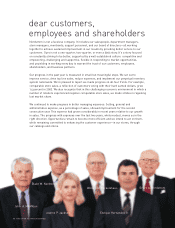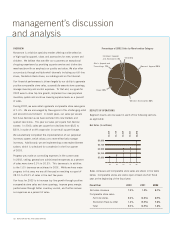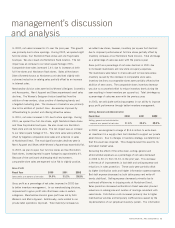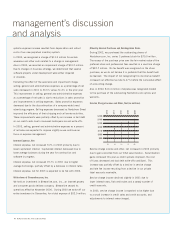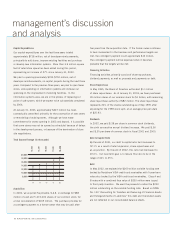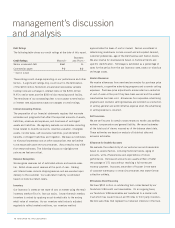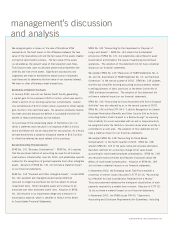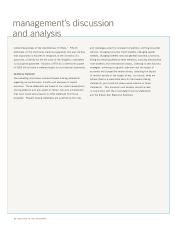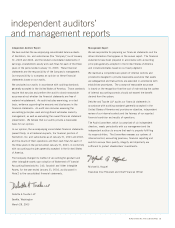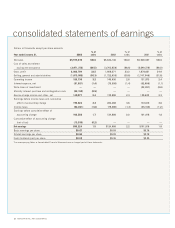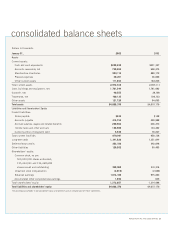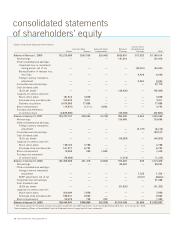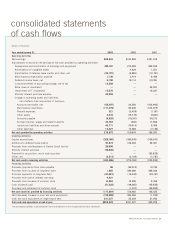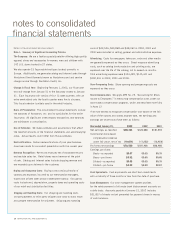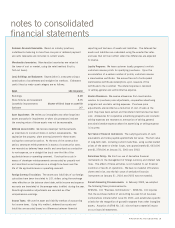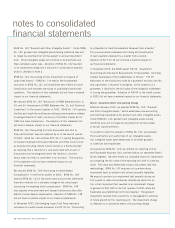Nordstrom 2002 Annual Report Download - page 20
Download and view the complete annual report
Please find page 20 of the 2002 Nordstrom annual report below. You can navigate through the pages in the report by either clicking on the pages listed below, or by using the keyword search tool below to find specific information within the annual report.
management’s discussion
and analysis
18 NORDSTROM INC. AND SUBSIDIARIES
Debt Ratings
The following table shows our credit ratings at the date of this report.
Standard
Credit Ratings Moody’s* and Poor’s*
Senior unsecured debt Baa1 A-
Commercial paper P-2 A-2
* negative outlook
These ratings could change depending on our performance and other
factors. A significant ratings drop could result in the termination
of the $200 million Nordstrom private label receivables variable
funding note and a change in interest rates on the $300 million
8.95% senior notes and the $300 million revolving credit facility.
The remainder of our outstanding debt is not subject to termination
or interest rate adjustments based on changes in credit ratings.
Critical Accounting Policies
The preparation of our financial statements requires that we make
estimates and judgments that affect the reported amounts of assets,
liabilities, revenues and expenses, and disclosure of contingent
assets and liabilities. We regularly evaluate our estimates including
those related to doubtful accounts, inventory valuation, intangible
assets, income taxes, self-insurance liabilities, post-retirement
benefits, contingent liabilities and litigation. We base our estimates
on historical experience and on other assumptions that we believe
to be reasonable under the circumstances. Actual results may differ
from these estimates. The following discussion highlights the
policies we feel are critical.
Revenue Recognition
We recognize revenues net of estimated returns and exclude sales
tax. Retail stores record revenue at the point of sale. Catalog
and Internet sales include shipping revenue and are recorded upon
delivery to the customer. Our sales return liability is estimated
based on historical return levels.
Inventory
Our inventory is stated at the lower of cost or market using the retail
inventory method (first-in, first-out basis). Under the retail method,
inventory is valued by applying a cost-to-retail ratio to the ending
retail value of inventory. As our inventory retail value is adjusted
regularly to reflect market conditions, our inventory method
approximates the lower of cost or market. Factors considered in
determining markdowns include current and anticipated demand,
customer preferences, age of the merchandise and fashion trends.
We also reserve for obsolescence based on historical trends and
specific identification. Shrinkage is estimated as a percentage of
sales for the period from the last inventory date, based on historical
shrinkage losses.
Vendor Allowances
We receive allowances from merchandise vendors for purchase price
adjustments, cooperative advertising programs and cosmetic selling
expenses. Purchase price adjustments are recorded as a reduction
of cost of sales at the point they have been earned and the related
merchandise has been sold. Allowances for cooperative advertising
programs and cosmetic selling expenses are recorded as a reduction
of selling, general and administrative expense when the advertising
or selling expense is incurred.
Self Insurance
We are self insured for certain losses related to health and welfare,
workers’ compensation and general liability. We record estimates
of the total cost of claims incurred as of the balance sheet date.
These estimates are based on analysis of historical data and
actuarial estimates.
Allowance for Doubtful Accounts
We evaluate the collectibility of our customer accounts receivable
based on several factors, including historical trends, aging of
accounts, write-off experience and expectations of future
performance. Delinquent accounts are usually written off after
the passage of 151 days without receiving a full scheduled
monthly payment. Accounts are written off sooner in the event
of customer bankruptcy or other circumstances that make further
collection unlikely.
Off-balance Sheet Financing
We have $200 million in outstanding term notes backed by our
Nordstrom VISA credit card receivables. On an ongoing basis,
our Nordstrom VISA receivables are transferred to a master note
trust which has issued Class A and B notes to third party investors.
We hold securities that represent our retained interests in the trust.




